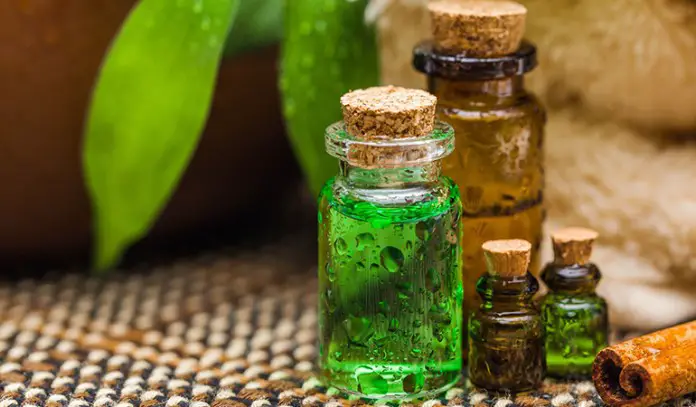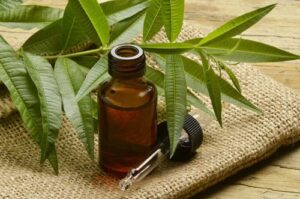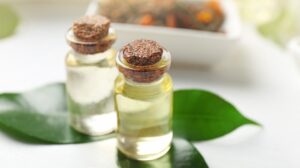Fleas can cause lots of harm to you and your pets. There are chemicals you can use to discard them. Still, you can opt for natural alternatives that are effective in killing fleas. An example is essential oils. But the big question is, does tea tree oil kill fleas?
If you’re also wondering if it’s safe for you and your pets, you’re in the right place. Not to mention, we’ll answer some of your frequently asked questions, so stick around.
What Is Tea Tree Oil?
Tea tree oil is extracted from the shrub Melaleuca Alternifolia, a native Australian tea tree plant. The liquid containing a complex mixture of compounds, including terpene, is removed from the plant leaves and used as a natural remedy for fleas and other parasites.
This tea tree oil has been in use since the 1770s due to its potent antimicrobial properties. The volatile oil is mainly seen as almost colorless or light-yellow. In historic times, the popular shrub, melaleuca, has been used to cure lots of skin conditions and used in pets to rid them of parasites.
You’ll find tea tree oil as a concentrated tea tree oil or a diluted oil mixture. It’s famous among aromatherapists and alternate natural medicine. The smell is almost like that of the camphor and is said to be its repelling. Traditional experts in veterinary medicine mostly recommend using the oil in minute quantities, especially on animals.
Even though oils from the tea tree are potent in their function, some cases highlight the risk and safety issues associated with its use, which we’ll delve into later.
How Does Tea Tree Oil Work?
There’s scientific evidence to the notion that tea tree oil treatment is effective for flea control in homes and around pets.
The tea tree oil has a very pungent odor that can repel fleas quite easily away from surrounding areas. In addition, it contains limonene, which affects fleas upon close contact. To elaborate, it interferes with the nervous system’s normal functioning, leading to paralysis and eventually to demise after a short period.
For antimicrobial agents like tea tree oil, they’re specific in their reaction to microbes and, in this case, parasites. That’s because one of the fundamental requirements for the existence of microbes is eliminated upon exposure to the tree oil.
Even though fleas sense their hosts by carbon dioxide exposure, they still respire oxygen, which will become poisoned upon exposure to the tea tree oil. The absence of good oxygen in a particular environment at a specific time will repel and kill them.
Fleas are primarily attracted to light and carbon dioxide. With its potent smell, the tea tree oil distracts the carbon dioxide-sensing mechanism of the flea, creating a barrier to prevent flea infestation.
The Facts About Tea Tree Oil and Fleas
Here are some facts you should know about the operation of the melaleuca oil:
- The tea tree oil is highly tolerant against certain bacteria, fungi, head lice, and even weevils.
- It has a strong smell, likened to camphor. Most people tend to find it unpleasant.
- The tea tree oil may cause skin problems to both humans and animals in uncontrolled quantities.
- Very few drops in enough water are potent and harmful to parasitic insects and bacteria.
- The correct dosage of the tree oil is the secret to efficient results.
Preparing Tea Tree Oil
You can purchase this essential tea tree oil in its original form from most pharmacies and grocery stores. We recommend proper dilution to a 1% concentration.
Even though classified as risky to prepare, you can carefully manufacture this tea tree oil in your local kitchen. At 1% concentration, you can dilute the oil with some cinnamon or nutmeg to make the aroma even stronger and the entire formula more potent. Then, transfer the mixture into a spray bottle, and shake the contents before application.
Using Tea Tree Oil
The components of the tea tree oil, like the limonene, make it potent. So, the correct application of tea tree oil can be highly effective. For your pets, you can rub the Melaleuca Alternifolia oil on their fur. But there are other uses involving your home and even you. Let’s look at each of these in detail.
For Pets
A study was conducted on 53 dogs to assess the effect of tea tree oil on them. The result indicates a very good response to treatment by 82%. This is a safe benchmark for use on your pet as well.
You should primarily consider the size of your pet when applying the tea tree oil onto its skin or fur. Generally, cats and dogs are more prone to flea attacks than other pets. But cats, without much consideration to size, don’t have a good track record of surviving high doses of this essential oil.
You can spray short bursts of the tea tree oil onto the collars of dogs. The smell isn’t so unpleasant to the dog as it is to the fleas that may hover around the dog.
So, you may spray the knee and toe region of the dog to keep the fleas away. With the spray bottle, you can equally spray your pet’s bedding and other areas they mostly play around to treat fleas.
With your cat, you should be very careful with the tea tree oil application. That’s because high levels can be dangerous. A low concentration is better to prevent skin irritations.
Since cats are known for licking their fur, apply minimal amounts whose oral ingestion will have no adverse effects. Be sure to stay away from your pet’s feeding tools at that time. Also, speak with your veterinarian on the right amounts of tea tree oil to apply.
Around the Home
It would help if you didn’t wait for a total flea infestation before you treat fleas. So, you can use the vacuum cleaner for your home, furniture, and carpets to kill flea eggs right after you’ve done some boom spraying of the essential tree oil around the mentioned areas.
Outside your home, you can also spray tree oil. Since it’s a natural product, its environmental effects are very minimal. Spray the oil around shrubs, weedy areas, garages, and outdoor kitchens. Continuously doing so ensures fleas are kept away for a long time.
For Humans
Tea tree oil can be helpful in several ways. For example, it can be sold as a hand sanitizer for disinfecting and killing bacteria like E Coli. And you can use it as a mosquito repellent to keep insects away, including fleas and ants. It may even be an ingredient in other human products like all-purpose cleaners.
On another note, daily activities cause our sweat glands to produce sweat. When sweat comes into contact with your skin, there’s an odor release. This odor can be prevented by using tea tree oil as a deodorant, thanks to its ability to fight bacteria.
Not to mention, when there’s an open wound, S. aureus can leach in and cause infection. Tea tree oil is effective in this regard. When it’s mixed with an essential oil like coconut oil and applied to the wound, it prevents infections and facilitates the healing process by working with the body’s white blood cells.
In addition, tea tree oil can fight skin conditions like acne and eliminate nail fungus. And a study demonstrates the effectiveness of oil when applied to treat skin irritations resulting from an allergy. It can also help reduce dandruff and even treat athlete’s foot infection.
Moreover, you can also use tea tree oil as a mouthwash to treat tooth decay and mouth odor.
What Are the Dangers of Tea Tree Oil?
Aside from its toxic effects on fleas, there are other dangers. Some people use it to cure allergies on their dog’s skin, which could result in serious side effects, such as irritable skin, adverse reactions, and fungal infections. It can be hazardous in large quantities.
In a study, undiluted oil was applied on three purebred cats. In a few hours, the first cat became hypothermic and uncoordinated. After a few more hours, the next cat went into a coma; by the end of the day, the third cat was hospitalized because it started trembling and had a strong odor of the oil.
After concluding the examinations, they were diagnosed with central nervous system depression and treated accordingly. But after a few days, 2 of the cats died.
The same goes for humans. Applying tea tree oil on sensitive skin can cause several reactions. When ingested, even in small quantities, it can cause toxic reactions.
Alternatives to Tea Tree Oil
We’ve listed some alternatives to tea tree oil below. Let’s take a look at them.
Diatomaceous Earth
Diatomaceous earth is an excellent alternative to tea tree oil. However, when applied to fleas, it breaks them down with time.
This alga has the same effect on worms and bugs when it’s fed to animals. Unlike tea tree oil, which may be toxic in small quantities, the diatomaceous earth is safe.
Other Essential Oils
Other essential oils are effective in use, but how do you know which ones to use? That’s why you have to monitor how your dog reacts to the essential oil before you use it for flea treatments. Just place a small amount near your dog, and observe its reaction.
A mixture of apple cider vinegar and salt works magic in flea repelling. Here’s what you should do. Dilute about 6 cups of vinegar into 4 cups of water and salt. Mix thoroughly, and spray on your dog.
During a warm bath, you can mix lemon juice with your pet’s shampoo. Then, leave the shampoo on your pet for a little while to get rid of the fleas.
Applying neem-safe essential oil is another alternative. It’s effective when applied directly or when mixed with your pet’s shampoo. You can also prepare a rosemary leaves solution and use it on your pet. Some pet owners consider coconut oil and aromatherapy spray effective on pets.
Collars
Next up, we have collars. The most effective is the lavender and cedar oil type. You can apply a dilution ratio directly to your dog.
Combs and Sachets
There are flea combs available for purchase. When you use one on your dog’s hair, it’ll remove the fleas from them. You can also use a lemon comb by putting your dog’s comb in lemon juice and using it on their hair.
A flea sachet is an option as well. It’s a bag that contains ingredients like lemon peel and lavender and is effective in getting rid of fleas if you place the sachet around your dog.
Foods and Drinks
Feeding your dog brewer’s yeast is an effective remedy for fleas. And an apple cider vinegar drink, just like the one mixed with salt and applied on your pet, helps get rid of fleas.
Cleaning
At the first sight of fleas, you can put blankets and other objects that may host them in the washing machine and wash them thoroughly. Afterward, use the tumble dryer, as the temperature and intensity can destroy the eggs and spores. This works like a steam clean, which goes a long way in repelling fleas.
Of course, vacuum your carpets and floors to remove the fleas from your home. When you’re done, take the cleaner outside, and open it gently so that the fleas don’t fly out.
Before you vacuum, you can spray salt on your floors and carpets to disarm the fleas. You can also use baking soda the same way. Leave them overnight for more effectiveness. After vacuuming, you can apply lemon juice spray on your couches, carpets, and floors.
These remedies have been proven effective in repelling fleas, but you should ask your veterinarian about the correct dosages before applying them.
Your garden is another place that fleas may be lurking in. Here are some things you can do to get rid of them:
- Tidy up your garden by removing the weeds and dirt.
- Clean up the damp areas by removing dead leaves and wet soil.
- You can introduce the worms that eat fleas into your garden.
- Lavender plants can repel fleas. It’ll go a long way if you plant it in your garden.
FAQs
Are Fleas Attracted to Tea Tree Oil?
Tea tree oil, like some other oils, including peppermint oil and lavender oil, can kill fleas when you use them in the right proportions and the right way.
What Kills Fleas Instantly?
Nitenpyram, also known as Capstar, can kill fleas instantly. You’d have to feed it to your dog, and it works in about 30 minutes. When you’re administering the Nitenpyram to your dog, try to keep it calm.
Is Tea Tree Oil Safe for My Dogs?
Yes, tea tree oil is safe for you to use on your dogs but only in small quantities. An undiluted oil applied in substantial amounts can be toxic to your dog as we’ve discussed above.
What Essential Oils Can I Use to Kill Fleas?
Essential oils are effective in getting rid of fleas. Examples are lavender oil, peppermint oil, rosemary oil, cedarwood oil, olive oil, jojoba oil, lemongrass oil, clove oil, and basil essential oils.
Does Tea Tree Oil Have Biological Effects?
Yes, it does. Tea tree oil has antibacterial, antifungal, antiviral, anti protozoan, and anti-inflammatory properties. That’s why it’s effective on skin and hair products (like to get rid of dandruff).
Last Words
Overall, we’ve rounded up everything you need to know about using the natural and herbal tea tree oil to get rid of fleas in your home, on your pets, and even in your garden.
Remember our safety precautions when using tea tree oil to prevent harm to you and your pets. Also, use diluted amounts of the oil with water and essential oils to reduce its toxicity.
Last but not least, consult your veterinarian before you apply any alternate flea treatment solutions.
References:
https://www.thesprucepets.com/does-tea-tree-oil-kill-fleas-5184098
https://www.theveterinarynurse.com/review/article/tea-tree-oil-exposure-in-cats-and-dogs
https://www.allthingsnature.org/how-do-i-use-tea-tree-oil-for-fleas.htm





